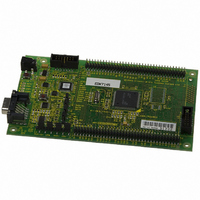EDK7145 Renesas Electronics America, EDK7145 Datasheet - Page 15

EDK7145
Manufacturer Part Number
EDK7145
Description
DEV EVALUATION KIT SH7145
Manufacturer
Renesas Electronics America
Type
MCUr
Datasheets
1.EDK7145.pdf
(19 pages)
2.EDK7145.pdf
(4 pages)
3.EDK7145.pdf
(5 pages)
4.EDK7145.pdf
(22 pages)
Specifications of EDK7145
Contents
2G (Second-generation) Evaluation Board, HEW debugger support, Cable and CD-ROM
Lead Free Status / RoHS Status
Contains lead / RoHS non-compliant
For Use With/related Products
SH7145
Lead Free Status / RoHS Status
Not Compliant, Contains lead / RoHS non-compliant
7.1.2.1.C
7.1.2.2.C
7.
7.1. HMON
HMON is an on-chip debugger from HMSE. It allows code to be debugged in Flash and/or RAM on their target hardware
using the MCU’s debug capabilities. It consists of HMON components for HEW communicating with HMON debugger code,
flash programming code and the developer’s application code running on the MCU. Most Hitachi MCUs include some on-chip
debugging functionality; this can comprise of software interrupt instructions (TRAP) and an address break peripheral unit.
HEW debugging functionality combined with HMON code and Flash programming code enables the developer to run, step
and set breakpoints in their application code as well as using other debugging functionality such as viewing memory and
C/C++ source code. Please refer to section 7.1.7 for restrictions on the use of the UBC with HMON.
7.1.1.
The HMON library is built to support Advanced Expanded Mode and Advanced Single Chip Mode only, modes 2 and 3, with
the clock mode set to (System clock = x4), (Peripheral clock = x2). The Device supports Modes 0, 1, 2 and 3, however On-
Chip ROM is active in modes 2 and 3.
7.1.2.
The monitor utilises the User Break Controller for code located in ROM, allowing a single breakpoint to be set in the code.
Code located in RAM may have multiple breakpoints limited only by the size of the On-Chip RAM.
Double clicking in the breakpoint column in the code sets the breakpoint. Adding a further breakpoint elsewhere in the code
removes the previous one.
Double clicking in the breakpoint column in the code sets the breakpoint. Breakpoints will remain unless they are double
clicked to remove them.
7.1.3.
HMON is built along with the debug code. Certain elements of the HMON code must remain at a fixed location in memory.
The following table details the HMON components and their size and location in memory. For more information, refer to the
map file when building code.
Section
RESET_VECTOR
HW_BREAK_VECTORS
TRAP_VECTORS
SCI_VECTORS
PHMON
CHMON
BHMON
FDTInit
UserModeMicroKernel
CUser_Vectors
C
ODE LOCATED IN
ODE LOCATED IN
ODE
D
M
B
H
EVELOPMENT
REAKPOINT
MON
ODE
S
C
UPPORT
ODE
FLASH / ROM
RAM
S
S
Description
HMON Reset Vector (Vector 0)
Required for Startup of HMON
HMON Break Controller (Vector 12)
Required by HMON to create Breakpoints in ROM
Trap Vectors (Vector 32, 33, 34, 35)
Required by HMON to create Trap Breakpoints in RAM
HMON Serial Port Vectors (Vector 132, 133, 134)
Used by HMON when EDK is configured to connect to the
default serial port.
HMON Code
HMON Constant Data
HMON Uninitialised data
FDT User Mode Kernel.
This is at a fixed location and must not be moved. Should the
kernel need to be moved it must be re-compiled.
UserModeMicroKernel.
This is at a fixed location and must not be moved. Should the
kernel need to be moved it must be re-compiled.
Pointer used by HMON to point to the start of user code.
This is at a fixed location and must not be moved for the Reset
CPU, and Go Reset commands to function.
IZE
UPPORT
Start Location
H’ 000000000
H’ 00000030
H’ 00000080
H’ 00000210
H’ 00003000
H’ FFFFF400
H’ 00001000
H’ 0003F800
H’ 00007000
H’ 00004f84
Size
(H’bytes)
4
4
10
C
1f84
140
25A
140
7B0
4
15























